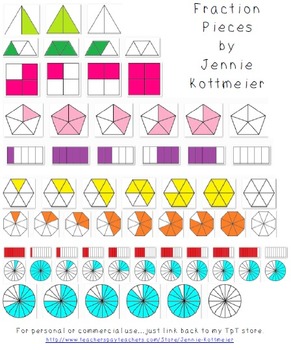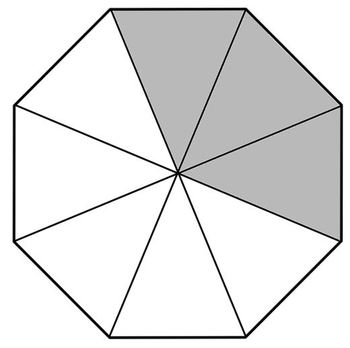Fraction Clip Art with Grayscale Pieces
Jennie Kottmeier
426 Followers
Grade Levels
2nd - 9th
Subjects
Resource Type
Standards
CCSS3.NF.A.3
CCSS4.NF.A.1
CCSS4.NF.A.2
CCSS4.NF.B.3
CCSS5.NF.A.1
Formats Included
- Zip
Pages
210 pages
Jennie Kottmeier
426 Followers
Description
GRAYSCALE PIECES ARE INCLUDED FOR EVERY IMAGE SHOWN IN THE PREVIEW
This set includes 210 pieces of clip art fractions (70 colored with white background and 70 colored without the white background, and 70 in grayscale without the white background) including halves, thirds, fourths, fifths, sixths, eights, tenths, and sixteenths. Shapes included: triangle, rectangle, square, trapezoid, rhombus, pentagon, hexagon, and octogon. These are for personal or commercial use. If using them commercially, please link back to my TpT store. Enjoy!
This set includes 210 pieces of clip art fractions (70 colored with white background and 70 colored without the white background, and 70 in grayscale without the white background) including halves, thirds, fourths, fifths, sixths, eights, tenths, and sixteenths. Shapes included: triangle, rectangle, square, trapezoid, rhombus, pentagon, hexagon, and octogon. These are for personal or commercial use. If using them commercially, please link back to my TpT store. Enjoy!
Total Pages
210 pages
Answer Key
N/A
Teaching Duration
N/A
Report this resource to TPT
Reported resources will be reviewed by our team. Report this resource to let us know if this resource violates TPT’s content guidelines.
Standards
to see state-specific standards (only available in the US).
CCSS3.NF.A.3
Explain equivalence of fractions in special cases, and compare fractions by reasoning about their size.
CCSS4.NF.A.1
Explain why a fraction 𝘢/𝘣 is equivalent to a fraction (𝘯 × 𝘢)/(𝘯 × 𝘣) by using visual fraction models, with attention to how the number and size of the parts differ even though the two fractions themselves are the same size. Use this principle to recognize and generate equivalent fractions.
CCSS4.NF.A.2
Compare two fractions with different numerators and different denominators, e.g., by creating common denominators or numerators, or by comparing to a benchmark fraction such as 1/2. Recognize that comparisons are valid only when the two fractions refer to the same whole. Record the results of comparisons with symbols >, =, or <, and justify the conclusions, e.g., by using a visual fraction model.
CCSS4.NF.B.3
Understand a fraction 𝘢/𝘣 with 𝘢 > 1 as a sum of fractions 1/𝘣.
CCSS5.NF.A.1
Add and subtract fractions with unlike denominators (including mixed numbers) by replacing given fractions with equivalent fractions in such a way as to produce an equivalent sum or difference of fractions with like denominators. For example, 2/3 + 5/4 = 8/12 + 15/12 = 23/12. (In general, 𝘢/𝘣 + 𝘤/𝘥 = (𝘢𝘥 + 𝘣𝘤)/𝘣𝘥.)





